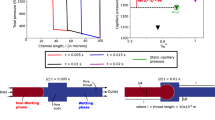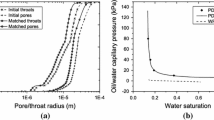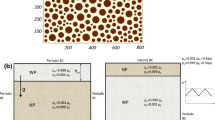Abstract
The capillary pressure–saturation (P c–S w) relationship is one of the central constitutive relationships used in two-phase flow simulations. There are two major concerns regarding this relation. These concerns are partially studied in a hypothetical porous medium using a dynamic pore-network model called DYPOSIT, which has been employed and extended for this study: (a) P c–S w relationship is measured empirically under equilibrium conditions. It is then used in Darcy-based simulations for all dynamic conditions. This is only valid if there is a guarantee that this relationship is unique for a given flow process (drainage or imbibition) independent of dynamic conditions; (b) It is also known that P c–S w relationship is flow process dependent. Depending on drainage and imbibition, different curves can be achieved, which are referred to as “hysteresis”. A thermodynamically derived theory (Hassanizadeh and Gray, Water Resour Res 29: 3389–3904, 1993a) suggests that, by introducing a new state variable, called the specific interfacial area (a nw, defined as the ratio of fluid–fluid interfacial area to the total volume of the domain), it is possible to define a unique relation between capillary pressure, saturation, and interfacial area. This study investigates these two aspects of capillary pressure–saturation relationship using a dynamic pore-network model. The simulation results imply that P c–S w relation not only depends on flow process (drainage and imbibition) but also on dynamic conditions for a given flow process. Moreover, this study attempts to obtain the first preliminary insights into the global functionality of capillary pressure–saturation–interfacial area relationship under equilibrium and non-equilibrium conditions and the uniqueness of P c–S w–a nw relationship.
Article PDF
Similar content being viewed by others
Avoid common mistakes on your manuscript.
Abbreviations
- a nw :
-
Specific interfacial area (m−1)
- \({A_{\rm dr}^{\rm nw}}\) :
-
Interfacial area in a pore body at \({s^{\rm w}=s_i^{{\rm dr}}}\) (m2)
- \({A_i^{\rm nw}}\) :
-
Interfacial area in a pore body (m2)
- C a :
-
Capillary number
- \({K_{i j}^{\alpha}}\) :
-
Conductance of phase α in pore throat i j (m4/Pa s)
- \({K_{i,i j}^{\rm w}}\) :
-
Wetting phase conductivity in pore body i next to pore throat i j (m4/Pa s)
- l i j :
-
Length of pore throat i j (m)
- l b :
-
Length of a blob (m)
- L i :
-
Total length of the edges in the pore body i (m)
- n pb :
-
Number of pore bodies
- \({p_i^{\alpha}}\) :
-
Pressure of phase α in the pore body i (Pa)
- \({p_{i}^{\rm c}}\) :
-
Capillary pressure in the pore body i (Pa)
- \({p_{{\rm e},i j}^{\rm c}}\) :
-
Entry capillary pressure of the pore throat i j (Pa)
- \({p_{i j}^{\rm c}}\) :
-
Capillary pressure of the pore throat i j (Pa)
- \({p_{i_{\rm tip}}^{\rm c}}\) :
-
Capillary pressure of the tip of the blob in pore i (Pa)
- \({\Delta p_{i-i j}^{\rm w}}\) :
-
Wetting phase pressure drop along the blob (Pa)
- \({\bar{p}_i}\) :
-
Total pressure in the pore i (Pa)
- P c :
-
Average capillary pressure (Pa)
- \({P_{\rm global}^{\rm c}}\) :
-
Global capillary pressure (Pa)
- \({P_{{\rm e}_{\rm block}}^{\rm c}}\) :
-
Maximum entry capillary pressure of a pore throat in contact with the non-wetting phase (Pa)
- r i j :
-
Radius of the pore throat i j (m)
- \({r_{i j}^{\rm c}}\) :
-
Radius of capillary pressure in the pore throat i j (m)
- \({r_{i j}^{\rm eff}}\) :
-
Effective hydraulic radius in the pore throat i j (m)
- R i :
-
Inscribed radius in the pore body i (m)
- \({s_i^{\alpha}}\) :
-
Volume fraction of phase α in the pore body i
- \({s_{i j}^{\rm w}}\) :
-
Volume fraction of phase α in the pore throat i j
- \({s_{i,{\rm min}}^{\rm w}}\) :
-
Minimum attainable volume fraction of wetting phase in the pore body i
- \({s_i^{\rm dr}}\) :
-
Wetting phase volume fraction for an inscribed sphere
- \({s_i^{\rm imb}}\) :
-
Wetting phase volume fraction at which only one pore throat will be filled with both phases
- \({s_i^*}\) :
-
Wetting phase volume fraction in the pore body i at which, all its pore throats can be filled by both phases
- S w :
-
Average saturation of the wetting phase
- Δt i :
-
Minimum residence time in the pore body i (s)
- Δt global :
-
Global residence time over the network (s)
- V i :
-
Volume of the pore body i (m3)
- V b :
-
Volume of a blob (m3)
- q n i :
-
Flux of non-wetting phase in the pore body i (m3/s)
- \({Q_{i j}^{\alpha}}\) :
-
Flux of phase α in the pore throat i j (m3/s)
- \({{\mathbb{N}}_i}\) :
-
Total number of pore throats connected to the pore i
- β :
-
Half-corner angle in a pore throat (rad)
- Γ :
-
A geometrical coefficient for calculating the corner conductance
- κ i :
-
Curvature of the interface in the pore body i (m−1)
- σ nw :
-
Interfacial tension (N/m)
- π :
-
3.1415
- θ :
-
Contact angle (rad)
- \({\epsilon}\) :
-
Resistance factor
- μ α :
-
Viscosity of phase α (Pa s)
References
Al-Gharbi M.S., Blunt M.J.: Dynamic network modeling of two-phase drainage in porous media. Phys. Rev. E 71, 016308 (2005). doi:10.1103/PhysRevE.71.016308
Azzam M.I.S., Dullien F.A.L.: Flow in tubes with periodic step changes in diameter: a numerical solution. Chem. Eng. Sci. 32, 1445–1455 (1977)
Blunt M., Jackson M.D., Piri M., Valvatne P.H.: Detailed physics, predictive capabilities and macroscopic consequences for pore-network models of multiphase flow. Adv. Water Resour. 25, 1069–1089 (2002)
Brakke K.: The surface evolver. Exp. Math. 1, 141–165 (1992)
Chen D.Q., Pyrak-Nolte L.J., Griffin J., Giordano N.J.: Measurement of interfacial area per volume for drainage and imbibition. Water Resour. Res. 43, W12504 (2007). doi:10.1029/2007WR0060217
Cheng J.T., Pyrak-Nolte L.J., Nolte D.D.: Linking pressure and saturation through interfacial area in porous media. Geophys. Res. Lett. 31, L08,502 (2004). doi:10.1029/2003GL019282
Dias M.M., Payatakes A.C.: Network models for two-phase flow in porous media part 1. immiscible microdisplacement of non-wetting fluids. J. Fluid Mech. 164, 305–336 (1986)
Fong, K.W., Jefferson, T.H., Suyehiro, T., Walton, L.: Guide to the slatec common mathematical library (1993). http://www.netlib.org/slatec
Hassanizadeh S.M., Gray W.G.: Mechanics and thermodynamics of multiphase flow in porous media including interphase boundaries. Adv. Water Resour. 13, 169–186 (1990)
Hassanizadeh S.M., Gray W.G.: Thermodynamic basis of capillary pressure in porous media. Water Resour. Res. 29, 3389–3405 (1993a)
Hassanizadeh S.M., Gray W.G.: Toward an improved description of the physics of two-phase flow. Adv. Water Resour. 16, 53–67 (1993b)
Hassanizadeh S., Celia M., Dahle H.: Dynamic effects in the capillary pressure–saturation relationship and their impacts on unsaturated flow. Vadose Zone J. 1, 38–57 (2002)
Held R.J., Celia M.A.: Modeling support of functional relationships between capillary pressure, saturation, interfacial area and common lines. Adv. Water Resour. 24, 325–343 (2001)
Joekar-Niasar, V., Hassanizadeh, S.M.: Analysis of fundamentals of two-phase flow in porous media using dynamic pore-network models; a review. Crit. Rev. Environ. Sci. Technol. accepted (2010)
Joekar-Niasar V., Hassanizadeh S.M.: Effect of fluids properties on non-equilibrium capillarity effects: Dynamic pore-network modeling. Int. J. Multiphase Flow 37(2), 198–214 (2011a)
Joekar-Niasar V., Hassanizadeh S.M.: Specific interfacial area; the missing state variable in two-phase flow?. Water Resour. Res. 47, W05513 (2011b). doi:10.1029/2010WR009291
Joekar-Niasar V., Hassanizadeh S.M., Leijnse A.: Insights into the relationships among capillary pressure, saturation, interfacial area and relative permeability using pore-network modeling. Transp. Porous Media 74(2), 201–219 (2008)
Joekar-Niasar V., Hassanizadeh S.M., Pyrak-Nolte L.J., Berentsen C.: Simulating drainage and imbibition experiments in a high-porosity micromodel using an unstructured pore network model. Water Resour. Res. 45, W02430 (2009). doi:10.1029/2007WR006641
Joekar-Niasar V., Hassanizadeh S.M., Dahle H.K.: Non-equilibrium effects in capillarity and interfacial area in two-phase flow: Dynamic pore-network modelling. J. Fluid Mech. 655, 38–71 (2010a). doi:10.1017/S0022112010000704
Joekar-Niasar V., Prodanovic M., Wildenschild D., Hassanizadeh S.M.: Network model investigation of interfacial area, capillary pressure and saturation relationships in granular porous media. Water Resour. Res. 46, W06526 (2010b). doi:10.1029/2009WR008585
Koplik J., Lasseter T.J.: Two-phase flow in random network models of porous media. Soc. Petrol. Eng. J. 25, 89–110 (1985). doi:10.2118/11014-PA
Lenormand R., Zarcone C.: Mechanism of the displacement of one fluid by another in a network of capillary ducts. J. Fluid Mech. 135, 337–353 (1983)
Mason, G., Morrow, N.R.: Meniscus configurations and curvatures in non-axisymmetric pores of open and closed uniform cross section. Proc. Royal Soc. London Ser. A 414(1846), 111–133 (1987). http://www.jstor.org/stable/2398111
Mogensen K., Stenby E.H.: A dynamic two-phase pore-scale model for imbibition. Transp. Porous Media 32, 299–327 (1998)
Ng K.M., Payatakes A.C.: Stochastic simulation of the motion, breakup and stranding of oil ganglia in water-wet granular porous media during immiscible displacement. AIChE J. 26, 419–429 (1980)
Patzek T.W.: Verification of a complete pore network simulator of drainage and imbibition. SPE J. 6, 144–156 (2001)
Porter M.L., Schaap M.G., Wildenschild D.: Lattice-boltzmann simulations of the capillary pressure–saturation–interfacial area relationship for porous media. Adv. Water Resour. 32(11), 1632–1640 (2009). doi:10.1016/j.advwatres.2009.08.009
Raeesi B., Piri M.: The effects of wettability and trapping on relationships between interfacial area, capillary pressure and saturation in porous media: A pore-scale network modeling approach. J. Hydrol. 376, 337–352 (2009). doi:10.1016/j.jhydrol.2009.07.060
Ransohoff T.C., Radke C.J.: Laminar flow of a wetting liquid along the corners of a predominantly gas-occupied noncircular pore. J. Coll. Int. Sci. 121, 392–401 (1988)
Reeves P.C., Celia M.A.: A functional relationship between capillary pressure, saturation, and interfacial area as revealed by a pore-scale network model. Water Resour. Res. 32, 2345–2358 (1996)
Washburn E.W.: The dynamics of capillary flow. Phys. Rev. 17, 273–283 (1921)
Zhou D., Blunt M.J., Orr F.M.: Hydrocarbon drainage along corners of noncircular capillaries. J. Coll. Int. Sci. 187, 11–21 (1997)
Acknowledgments
The authors are members of the International Research Training Group NUPUS, financed by the German Research Foundation (DFG) and The Netherlands Organization for Scientific Research (NWO). This research was also partly funded by a King Abdullah University of Science and Technology (KAUST) Center-in-Development Award to Utrecht University (Grant No. KUK-C1-017-12).
Open Access
This article is distributed under the terms of the Creative Commons Attribution License which permits any use, distribution, and reproduction in any medium, provided the original author(s) and the source are credited.
Author information
Authors and Affiliations
Corresponding author
Rights and permissions
Open Access This article is distributed under the terms of the Creative Commons Attribution 2.0 International License (https://creativecommons.org/licenses/by/2.0), which permits unrestricted use, distribution, and reproduction in any medium, provided the original work is properly cited.
About this article
Cite this article
Joekar-Niasar, V., Hassanizadeh, S.M. Uniqueness of Specific Interfacial Area–Capillary Pressure–Saturation Relationship Under Non-Equilibrium Conditions in Two-Phase Porous Media Flow. Transp Porous Med 94, 465–486 (2012). https://doi.org/10.1007/s11242-012-9958-3
Received:
Accepted:
Published:
Issue Date:
DOI: https://doi.org/10.1007/s11242-012-9958-3




